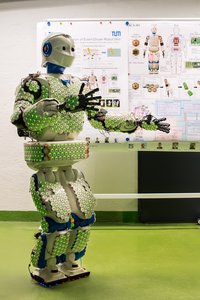Humanoid Robotics
Contact:
Description

© A. Eckert / TUM
Contact: Julio Rogelio Guadarrama Olvera
Among all the problems concerning humanoid robotics, the biped locomotion is one of the most important and difficult due to its naturally unstable dynamics. This problem has been addressed from different approaches that can be divided in two categories.
Kinetically controlled: These approaches use simplified models to generate slow and stable primitive curves for the legs and the center of mass. Those motion patterns are then transformed into joint position commands. This kind of implementations are computationally lighter and robust to disturbances but have less efficiency on the generated gaits.
Dynamically controlled: These implementation take in account the dynamic properties of the system to generate force and moment patterns to maintain balance and generate efficient gaits. These implementations require torque commanded joints and heavy computations due to the complexity of the dynamic equations involved and lack of robustness against external stimuli.
For both approaches, external contacts are undesired and may lead to falling scenarios causing harm in the robot and the surrounding objects. Contrary to this, human beings use contacts on our favour, for instance, we use hand bars to keep balance while climbing stairs or lean against a wall to save energy and prevent tiredness. We can get in contact with the environment because we have enough information to keep these contacts under safe and controlled conditions. We collect data from our skin and proprioception to analyze the environment. We can measure the friction against a surface to verify a grip and apply force before leaning to make sure that a wall can support our weight.
Following this idea, if a robot is capable of collecting more information from the environment, the robot can exploit contacts on its favor. These data can be combined with dynamic models, for instance, to keep balance in complex environments, to handle unstructured objects, to comply to external forces and to interact with the environment. Furthermore, in tight or cluttered environments, it can apply forces looking for movable objects to reconfigure the environment in order to achieve locomotion where standard methods may fail.
Our research focuses on the development of control techniques to handle intentional and non-intentional contacts to achieve locomotion in complex environments even coming to modify the environment in order to enable locomotion.